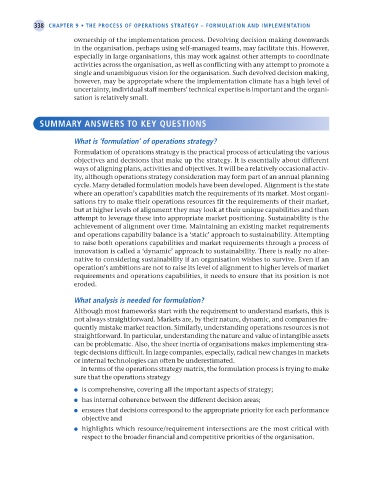Page 363 - Operations Strategy
P. 363
338 CHAPTER 9 • THE PRoCEss of oPERATions sTRATEgy – foRmulATion And imPlEmEnTATion
ownership of the implementation process. Devolving decision making downwards
in the organisation, perhaps using self-managed teams, may facilitate this. However,
especially in large organisations, this may work against other attempts to coordinate
activities across the organisation, as well as conflicting with any attempt to promote a
single and unambiguous vision for the organisation. Such devolved decision making,
however, may be appropriate where the implementation climate has a high level of
uncertainty, individual staff members’ technical expertise is important and the organi-
sation is relatively small.
summARy AnsWERs To kEy quEsTions
What is ‘formulation’ of operations strategy?
Formulation of operations strategy is the practical process of articulating the various
objectives and decisions that make up the strategy. It is essentially about different
ways of aligning plans, activities and objectives. It will be a relatively occasional activ-
ity, although operations strategy consideration may form part of an annual planning
cycle. Many detailed formulation models have been developed. Alignment is the state
where an operation’s capabilities match the requirements of its market. Most organi-
sations try to make their operations resources fit the requirements of their market,
but at higher levels of alignment they may look at their unique capabilities and then
attempt to leverage these into appropriate market positioning. Sustainability is the
achievement of alignment over time. Maintaining an existing market requirements
and operations capability balance is a ‘static’ approach to sustainability. Attempting
to raise both operations capabilities and market requirements through a process of
innovation is called a ‘dynamic’ approach to sustainability. There is really no alter-
native to considering sustainability if an organisation wishes to survive. Even if an
operation’s ambitions are not to raise its level of alignment to higher levels of market
requirements and operations capabilities, it needs to ensure that its position is not
eroded.
What analysis is needed for formulation?
Although most frameworks start with the requirement to understand markets, this is
not always straightforward. Markets are, by their nature, dynamic, and companies fre-
quently mistake market reaction. Similarly, understanding operations resources is not
straightforward. In particular, understanding the nature and value of intangible assets
can be problematic. Also, the sheer inertia of organisations makes implementing stra-
tegic decisions difficult. In large companies, especially, radical new changes in markets
or internal technologies can often be underestimated.
In terms of the operations strategy matrix, the formulation process is trying to make
sure that the operations strategy
● is comprehensive, covering all the important aspects of strategy;
● has internal coherence between the different decision areas;
● ensures that decisions correspond to the appropriate priority for each performance
objective and
● highlights which resource/requirement intersections are the most critical with
respect to the broader financial and competitive priorities of the organisation.
M09 Operations Strategy 62492.indd 338 02/03/2017 13:27

